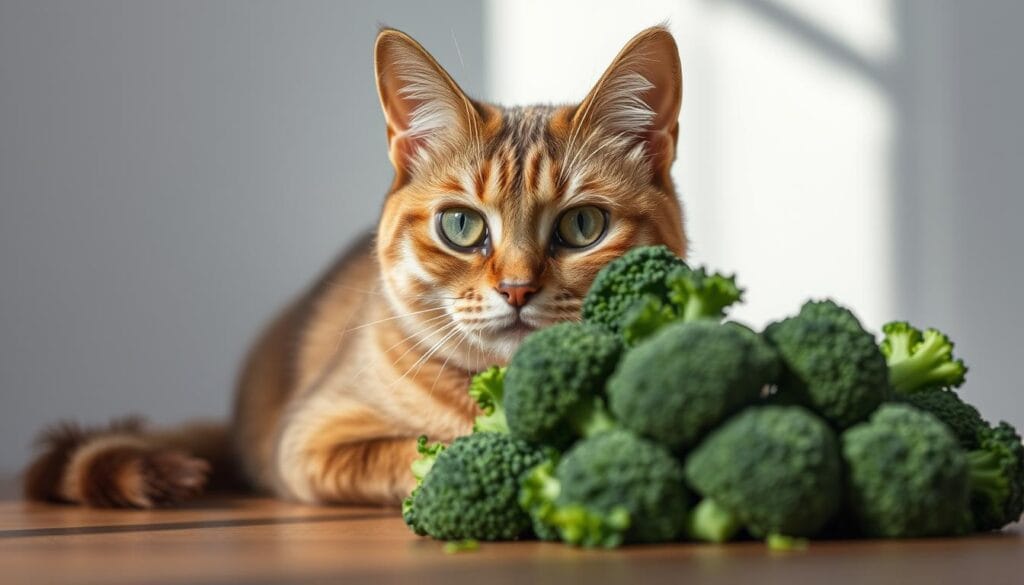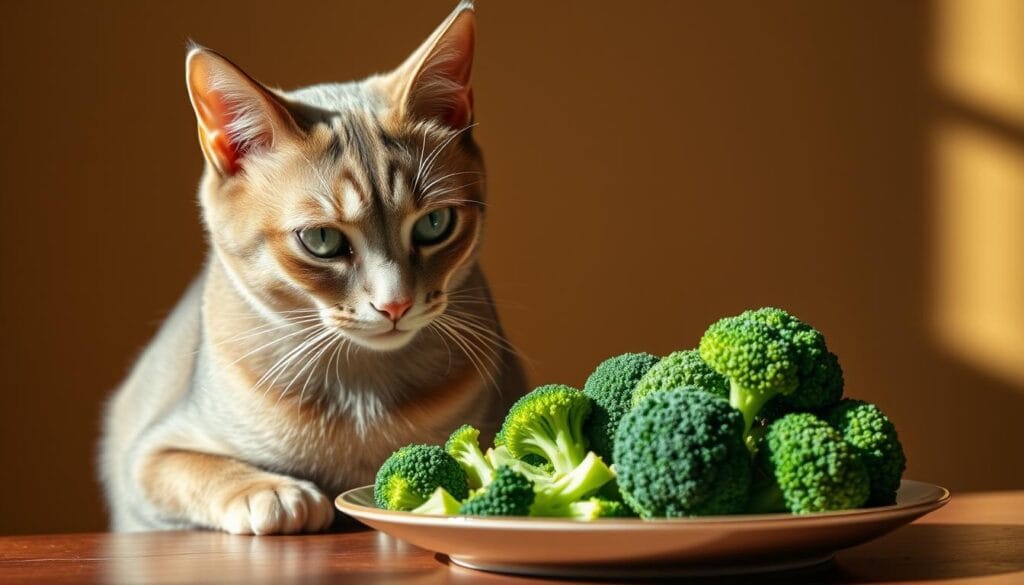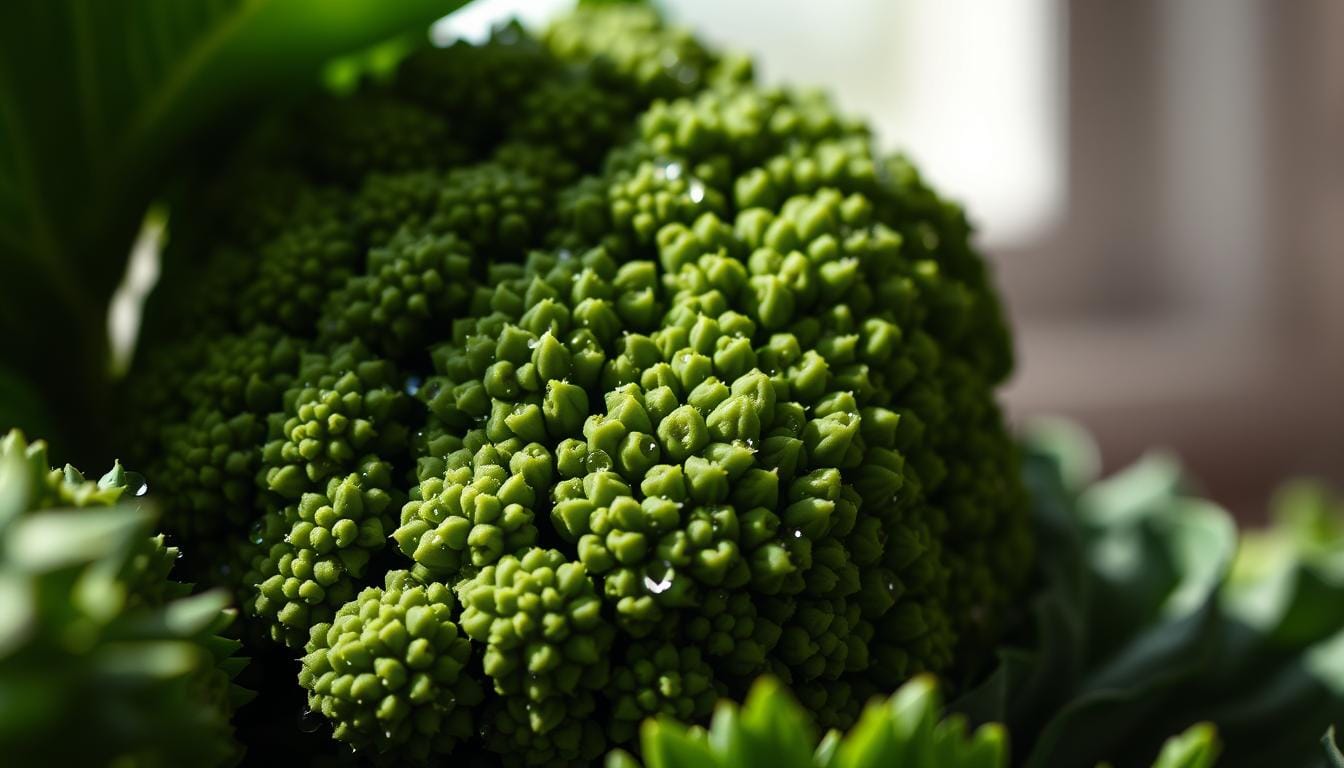can cats have broccoli? Facts & Feeding Tips
can cats have broccoli?
You’ve probably wondered about sharing your favorite veggies with your furry companion. Picture this: your curious feline sniffs at your plate while you chop fresh greens. That moment of hesitation—is it safe?—is more common than you think.
Vegetables like broccoli offer vitamins and fiber, but pets thrive on tailored diets. As obligate carnivores, their bodies prioritize meat-based nutrients. Still, small portions of certain plants can add variety to meals.
Table of Contents
This crunchy green contains vitamin C, vitamin K, and antioxidants. While not essential for felines, it may support digestion when prepared properly. Steaming florets softens them, making chewing easier for your pet.
Moderation matters most. Introduce new foods slowly to avoid stomach upset. Observe reactions closely, and consult your vet if unsure. Your companion’s well-being always comes first.
Understanding Your Cat’s Dietary Needs
Decoding your pet’s meals starts with their biological blueprint. Unlike humans, obligate carnivores rely almost entirely on meat to meet nutritional demands. Their bodies evolved to extract energy from proteins and fats rather than plant matter.
Feline Nutrition 101
A meat-centric fuels essential bodily functions. Animal tissues provide taurine – an amino acid critical for heart health and vision. Without it, pets risk developing severe deficiencies over time.
| Trait | Feline System | Human System |
|---|---|---|
| Digestive Tract Length | Shorter | Longer |
| Primary Energy Source | Proteins | Carbohydrates |
| Plant Fiber Processing | Limited | Efficient |
The Role of Meat vs. Vegetables
While leafy greens might seem healthy, they lack the dense nutrients carnivores require. Plant-based often passes through undigested, offering minimal benefits. Focus instead on high-quality proteins that support muscle maintenance and organ function.
Can Cats Have Broccoli: A Closer Look
Many pet owners question if their feline’s diet needs plant-based variety. While meat remains essential, occasional veggie treats can spark interest. The key lies in balancing curiosity with nutritional science.
Exploring the Main Facts
Broccoli stands out as a non-toxic option for pets. Unlike onions or garlic, which are dangerous, this green veggie rarely causes harm. Steamed florets provide fiber without added fats or seasonings.
| Vegetable | Safety Status | Notes |
|---|---|---|
| Broccoli | Safe | Offer cooked, bite-sized pieces |
| Onions | Unsafe | Causes blood cell damage |
| Spinach | Caution | Risk of kidney stones |
When and Why You Might Include It
Use broccoli as a training reward for pets watching their weight. If your companion sniffs your plate persistently, a tiny portion satisfies curiosity. Always monitor stool quality after introducing new foods.
Remember: Veggies supplement—not replace—protein-rich meals. Consult your vet before making dietary changes, especially for pets with health conditions.
Nutritional Benefits of Broccoli for Cats
When considering treats for your feline friend, nutritional value should always lead the conversation. This green vegetable packs a surprising punch of compounds that support bodily functions. Though not a dietary staple, its components can complement meat-based meals when used thoughtfully.
Vitamins, Fiber, and Antioxidants
Antioxidants in this veggie neutralize free radicals, protecting cells from damage. This boosts immune system resilience against environmental stressors. The fiber content aids digestion by regulating bowel movements and improving stool texture.
Vitamin K ensures proper blood clotting, while folic acid supports red blood cell production. Potassium maintains muscle function and fluid balance, vital for heart health. Together, these nutrients create a protective network for organs and tissues.
| Nutrient | Key Benefit | Serving Tip |
|---|---|---|
| Antioxidants | Fights cellular damage | Steam florets lightly |
| Fiber | Supports gut health | Chop into pea-sized pieces |
| Vitamin K | Promotes clotting | Mix with regular food |
| Potassium | Maintains muscle function | Limit to 1-2 bites weekly |
Understanding Health Perks in Moderation
Small portions offer health benefits without overwhelming carnivorous digestive systems. Overfeeding may cause gas or loose stools, so introduce gradually. Use it as a low-calorie snack alternative for weight management.
The immune system gains extra support from antioxidants, while fiber helps prevent constipation. Always prioritize protein sources and consult your vet before adding new foods to meals.
Risks and Cautions of Feeding Broccoli
While broccoli offers potential benefits, understanding its risks ensures your pet’s safety. Even harmless foods can cause problems when introduced carelessly. Moderation and preparation determine whether this veggie becomes a treat or trouble.

Digestive Upset and Overfeeding Concerns
Too much broccoli often leads to digestive issues. Watch for signs like vomiting diarrhea or unusual lethargy. These symptoms typically appear within 24 hours of consumption.
High fiber content speeds digestion, causing loose stools. Pets with sensitive stomachs may react more severely. Start with rice-sized portions to test tolerance.
| Risk | Prevention | Action |
|---|---|---|
| Choking | Chop stems into ¼-inch cubes | Remove uneaten pieces promptly |
| Digestive Blockage | Steam florets until soft | Contact vet if appetite changes |
| Overfeeding | Limit to 1 teaspoon weekly | Track treat calories |
| Allergic Reaction | Introduce solo, not mixed | Stop feeding if itching occurs |
Choking Hazards and Portion Control
Crunchy stems pose a choking hazard, especially for enthusiastic eaters. Always cut vegetables smaller than your pet’s kibble. Avoid serving raw pieces to kittens or seniors.
Monitor chewing habits during initial feedings. Store prepared broccoli in airtight containers for freshness. Discard leftovers after 48 hours to prevent bacterial growth.
Persistent digestive issues after small servings might indicate food intolerance. Consult your veterinarian if vomiting diarrhea lasts over 12 hours. Your companion’s health always comes first.
Proper Preparation: How to Serve Broccoli Safely
Transforming broccoli into a feline-friendly snack starts with meticulous preparation. Simple steps ensure this vegetable becomes a safe addition to meals rather than a digestive hazard.
Washing and Chopping Techniques
Thoroughly rinse florets and stems under cool running water. This removes dirt, pesticides, and bacteria that could harm your pet. Pat dry with a clean towel before cutting.
Slice stems into ¼-inch cubes and florets into pea-sized pieces. Smaller portions prevent choking and aid digestion. Avoid large chunks, especially for kittens or seniors.
Cooking Methods: Steaming, Boiling, or Raw?
Steaming preserves nutrients best while softening the texture. Boiling works but may reduce vitamin content. Raw pieces are acceptable if finely chopped, though cooked versions digest easier.
| Method | Benefits | Tips |
|---|---|---|
| Steaming | Retains 90% nutrients | Cook 3-5 minutes until tender |
| Boiling | Quick preparation | Use minimal water, drain well |
| Raw | Natural enzymes intact | Chop smaller than kibble |
Make sure all servings are plain—no oils, salt, or seasonings. Introduce one method at a time to monitor reactions. Store leftovers in airtight containers for up to two days.
Determining the Right Serving Size for Your Cat
Navigating treat portions requires precision to maintain your pet’s health. Start with a speck-sized piece of steamed broccoli – think smaller than a pea. Observe closely for 48 hours to spot unusual behaviors or digestive changes.

Tips for Introducing New Foods
Gradual introduction prevents digestive upset. Offer a single floret crumb alongside regular meals. Track litter box habits and energy levels for subtle changes.
| Step | Signs to Watch | Action Required |
|---|---|---|
| Day 1-2 | Normal appetite | Increase to ¼ tsp |
| Day 3-5 | Consistent stool | Offer weekly treats |
| Week 2+ | Rejection or disinterest | Pause and reassess |
Guidelines on Frequency and Amount
Treats should never overshadow core nutrition. Limit broccoli to thumb-tip portions twice weekly. Pair with interactive toys to slow eating and enhance mental stimulation.
| Portion Size | Frequency | Key Consideration |
|---|---|---|
| 1/8 tsp | Initial test | Mix with wet food |
| 1 tsp | Weekly maximum | Count toward 10% treat rule |
| 2 tsp | Not recommended | Risk of nutrient imbalance |
Adjust quantities based on your companion’s weight and activity level. Always consult your veterinarian before altering meal plans significantly.
Integrating Broccoli into a Balanced Feline Diet
Crafting a nutritious meal plan for your pet involves more than protein staples. While meat remains central, occasional plant-based snacks add texture and variety. Focus on pairing broccoli with complementary foods that align with carnivorous needs.
Complementary Treats and Cat-Safe Foods
Lean proteins like cooked chicken or turkey form the foundation of healthy diets. For veggie options, steamed carrots or green beans offer crunch without overwhelming digestive systems. Rotate these with small broccoli florets to create interest during mealtimes.
Fish such as salmon provides omega-3 fatty acids, while diced pumpkin aids digestion. Always serve vegetables cooked and unseasoned. Treats should make up less than 10% of daily calories to maintain nutritional balance.
Monitor your pet’s reactions to new foods. Combine exploration with caution—introduce one item weekly. This approach helps identify preferences and avoids diet disruptions. Consult your vet to tailor choices based on health history.
- Can Cats Eat Oranges? The Surprising Truth
- Can Cats Eat Blueberries? Benefits and Risks Explained
- Can Cats Eat Grapes? Vet Answers and Safe Alternatives
- Can Cats Eat Mango? What Every Cat Owner Should Know
- Can Cats Eat Pineapple? Safety Tips for Cat Owners

